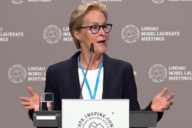You have /5 articles left.
Sign up for a free account or log in.
It's not unusual to hear complaints over life insurance. But this one comes from a university, and it's over 64 policies, not just one.
Last week, the University of the Ozarks filed a breach-of-contract lawsuit in federal court alleging that a group of insurance companies worked to defraud it of several million dollars over almost two decades. The companies agreed to administer a fund raising program in which donors would purchase life insurance policies that would, in theory, start paying for themselves. The university would then collect the total value of the policies, as the listed benefactor, once donors either passed away or reached the age of 95.
The program, called LIFEndowment, certainly sounded like a bargain when the university first signed a contract with Ketchum Inc. in May 1985. The terms were enviable: Donors would purchase life insurance, paying the university directly for five years' worth of premiums, which it would then pay to the insurance provider. The company said that because of interest -- at a projected 10.5 percent -- the policy would being paying for itself after the fifth year, and at that time the university could being withdrawing up to 10 percent of the total funds each year.
The university, then called the College of the Ozarks, agreed to pay $175,500 plus expenses for Ketchum's services in raising a projected $7 million for its fund raising campaign. Sixty-four donors eventually signed up for the program, paying a total of nearly $400,000 in premiums that the lawsuit says were to have been worth $3.7 million in total insurance coverage once the policies were cashed out.
But according to the suit, Crown Life Insurance, one of the named defendants that participated in the LIFEndowment program, canceled the insurance coverage in 2002 of one Helen Walton -- wife of Wal-Mart founder Sam Walton and heir to much of the vast family fortune -- without notice. In 2003, another policy was canceled, and the suit claims "anticipatory breach of contract" for the other 62.
Helen Walton died last month, leaving much of her wealth to the Walton Family Foundation, which supports charter schools and vouchers as methods of K-12 education reform. Per the original contract, had her policy not been terminated, the total value -- over $100,000 -- would have been paid to the university. A representative of the foundation declined to comment on the lawsuit, which does not name Walton as a plaintiff.
"We’re going to the mat for our donors," said Larry Isch, director of public relations at University of the Ozarks. "We and [the donors] were told one thing, and we want to see that that happened."
Potentially, if the 10.5-percent interest rate was not sustainable over the period in which the donors held their policies, the life insurance providers would not have been able to hold their end of the bargain -- that after five years, the policies would be self-sustaining. But the lawsuit goes further, alleging that the companies may have known in advance that they were defrauding the university.
The LIFEndowment name lives on. Robert L. Thompson, currently a director at the fund raising consulting firm Skystone Ryan, helped develop LIFEndowment, Inc., in 1985 but wouldn't comment on the lawsuit. The LIFEndowment program is now administered at the firm, which was not named in the complaint. And S. Wylie Milligan, a former chairman at LIFEndowment, Inc., is "retired" and said the company has "been dissolved for 10 years." Both Thompson and Milligan are named defendants; none of the others listed, including Ketchum, Canada Life, and Crown Life Insurance (since acquired by Canada Life), could be reached for comment.
The LIFEndowment program is similar to one announced in March by Oklahoma State University, in which 27 individuals qualifying for $10 million life insurance policies committed to naming the university's athletics department as their beneficiary -- a potential windfall of $270 million. The initiative came from T. Boone Pickens, who recently donated $165 million of his own to the athletics program. The difference between the two programs is that Oklahoma State will be paying the premiums itself with money donated from other sources, according to Gary Shutt, the university's director of communications.
"We certainly did a very thorough and due diligence, so we are confident that this is an exciting opportunity and program to raise long-term dollars for our athletic program," Shutt said. "We took all the steps and are very confident that this will be a very successful program for us."




